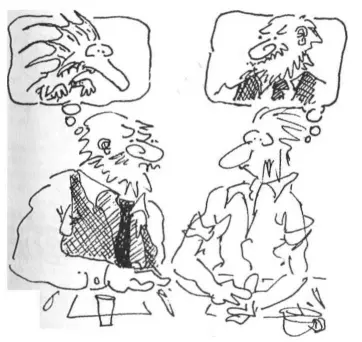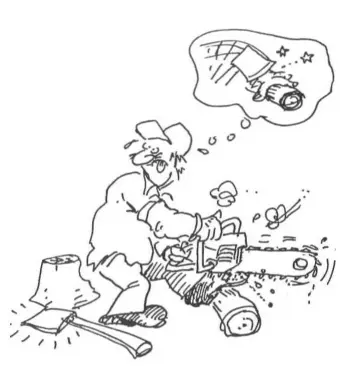Richard Bandler - Using Your Brain —for a CHANGE
- Название:Using Your Brain —for a CHANGE
- Автор:
- Жанр:
- Издательство:Real People Press
- Год:1985
- Город:Moab, Utah
- ISBN:0–911226–26–5
- Рейтинг:
- Избранное:Добавить в избранное
-
Отзывы:
-
Ваша оценка:
Richard Bandler - Using Your Brain —for a CHANGE краткое содержание
Bandler is an innovator and an original thinker in the field of psychology. This book is a transcript of Bandler live in front of an audience, cutting up and cracking jokes as he is prone to do, talking about some of his unique and often practical views on how you can change your feelings, thoughts and behavior. Change is often easier than you think if you use the right method.
Using Your Brain —for a CHANGE - читать онлайн бесплатно полную версию (весь текст целиком)
Интервал:
Закладка:
If you can be terrified of an elevator, and then learn to respond differently, it seems like you should be able to change any pattern of behavior, because terror's a pretty strong behavior. Fear is an interesting thing. People move away from it. If you tell someone to look at something she's terrified of, she can't look at it. However, if you tell her to see herself looking at it, she's still looking at it, but for some reason she can do it that way. It's the same as the difference between sitting in the front seat of a roller coaster and sitting on a bench seeing yourself in a roller coaster. That is enough for people to be able to change their responses. You can use the same procedure with victims of rape, child abuse, and war experiences: "post–traumatic stress syndrome."
Years ago it took me an hour to work with a phobia. Then when we learned more about how a phobia works, we announced the ten–minute phobia cure. Now I've got it down to a few minutes. Most people have a hard time believing that we can cure a phobia that fast. That's really funny, because I can't do it slowly. I can cure a phobia in two minutes, but I can't do it in a month, because the brain doesn't work that way. The brain learns by having patterns go by rapidly. Imagine if I gave you one frame of a movie every day for five years. Would you get the plot? Of course not. You only get the meaning of the movie if all those pictures go by really fast. Trying to change slowly is like having a conversation one word a day.
Man: How about practice, then? When you create a change once, like with Joan, does she have to practice?
No. She's already changed, and she won't have to practice, or think about it consciously. If change work is hard, or takes much practice, then you're going about it in the wrong way, and you need to change what you're doing. When you find a path without resistance, you're combining resources, and doing it once is plenty. When Joan went into the elevator during the break, she didn't have to try not to be terrified. She was already changed, and that new response will last as well as the original terror.
One of the nice things about someone with a phobia is that she's already proved that she's a rapid learner. Phobics are people who can learn something utterly ridiculous very quickly. Most people tend to look at a phobia as a problem, rather than as an achievement. They never stop to think, "If she can learn to do that, then she should be able to learn to do anything."
It always amazed me that someone could learn to be terrified so consistently and dependably. Years ago I thought, "That's the kind of change I want to be able to make," That led me to wonder, "How could I give someone a phobia?" I figured that if I couldn't give someone a phobia, I couldn't be really methodical about taking it away.
If you accept the idea that phobias can only be bad, that possibility would never occur to you. You can make pleasant responses just as strong and dependable as phobias. There are things that people see and light up with happiness every single time — newborns, or very small children will do it for nearly every one. If you don't believe it, I have a challenge for you: find the toughest, meanest–looking dude you can find, put a small baby in his arms and have him walk around inside a supermarket. You follow a couple of steps behind and watch how people respond.
I want to warn you about something, however: the phobia cure takes away feelings, and it will work for pleasant memories, too. If you use the same procedure on all your loving memories of being with someone, you can make that person into just as neutral an experience as an elevator! Couples often do this naturally when they get divorced. You can look at that person you once loved passionately, and have no feelings about her whatsoever. When you recall all the nice things that happened, you'll be watching yourself have fun, but all your nice feelings will be gone. If you do this when you're still married, you're really in trouble.
It's one thing to review all the experiences you have had with someone — pleasant and unpleasant — and decide that you want to end the relationship and move on. But if you dissociate from all the good times you had with that person, you'll be throwing away a very nourishing set of experiences. Even if you can't stand to be with her now, because you've changed or she's changed, you may as well enjoy your pleasant memories.
Some people go on to dissociate from all the pleasant experiences they're having now, "so they won't be hurt again later." If you do that, you won't be able to enjoy your own life even when it's nice. It will always be like watching someone else having fun, but you never get to play. If you do that with all your experiences, you'll become an existentialist — the ultimate totally uninvolved observer.
Some people see a technique work and decide to try it with everything. Just because a hammer works for nails doesn't mean everything needs to be pounded. The phobia procedure is effective in neutralizing strong feeling responses — positive or negative — so be careful what you use it for.
Do you want to know a good way to fall in love? Just associate with all your pleasant experiences with someone, and dissociate from all the unpleasant ones. It works really well. If you don't think about the unpleasant experiences at all, you can even use this method to fall in love with someone who does lots of things you don't like. The usual method is to fall in love this way and then get married. Once you're married, you can turn this process around so that you associate with the unpleasant experiences and dissociate from the pleasant ones. Now you respond only to the unpleasant things, and you wonder why "they've changed!" They didn't change, your thinking did.
Woman: Are there any other ways to do phobias? I'm scared silly of dogs.
There are always other ways to do things; it's a matter of "Do we know about them yet?" "Are they as dependable?" "How long do they take?" "What else will they affect?" and so on.
Try this: go back and recall a memory of something exquisitely pleasurable, exciting, and humorous from your past, and see what you saw at the time that it occurred. Can you find a memory like that? . . . (She starts to smile.) That's good. Turn the brightness up a little bit, . . . (She smiles more.) That's fine. Now keep that picture and have a dog come right through the middle of that picture and then become a part of that picture. As it does that, I want you to make the picture a little bit brighter. . . .
Now imagine being in the same room with a dog, to see if you're still phobic. . . .
Woman: I feel fine when I think of it now.
That procedure is a variation of another method I'll teach you later. It's not quite as dependable as dissociation for very strong phobias, but it will usually work. I've done a lot of phobias, so I'm bored with them, and I usually just do the fastest and most dependable thing I know. Now that you know it, you can do it, too. But if you really want to understand how brains work, the next time you have a phobic client, take a little longer. Ask a lot of questions to find out how this particular phobia works. For instance, sometimes a phobic person will make the picture of the dog, or whatever it is, very large, or bright, or colorful, or run a movie very slowly, or over and over again. Then you can try changing different things to find out how you can change this particular person's experience. When you get tired of that, you can always pull the quick cure out of your hip pocket and get rid of her in five minutes. If you do that kind of experimenting, you'll start learning how to generate NLP, and you won't have to pay to come to seminars any more.

IV. Going Wrong

I once asked a friend, "What is the biggest failure in your life?" He said, "In a couple of weeks I'm going to do this thing and it's not going to work out." You know what? He was right! It was the biggest failure of his life — not because it didn't work out, but because he took the time to feel bad about it ahead of time. Many people use their imagination only to discover all the things that would make them feel bad, so they can feel bad about it now. Why wait?"}
Why wait until your husband goes out and has an affair? Imagine it now; see him out there having fun with someone else. Feel as if you're there watching it all. You can make yourself hideously jealous, just like that. How many of you have done that?
Then if you're still feeling terrible when he comes home, you can yell and scream at him and drive him away, so that it will actually happen. Clients have come in and told me that they did this. I listen to them and I ask, "Why don't you make good pictures?" "What do you mean?" "Change that picture until you can see yourself there with him instead of that other woman. Then step into the picture and enjoy all those good feelings. Then when he gets home, make him want to do it with you." Do you like that better?
People often talk about having "good" and "bad" memories; but that's just a statement about whether they liked them or not. Most people want to have only pleasant memories, and think they'd be much happier if all their bad memories went away. But imagine what your life would be like if you never had any bad experiences! What if you grew up and everything was wonderful all the time? You'd grow up to be a wimp, totally unable to cope; there are quite a few examples in this country.
Once I had a 24–year–old client who had been on valium since he was twelve. The only time he left his house was to go to the dentist, the doctor, or the psychiatrist. He'd been through five psychiatrists, but as far as I could tell, the major thing that was wrong with him was that he hadn't left his house in twelve years. Now his mother and father thought he should be out on his own. His father owned a big construction company, and complained to me, "That boy, it's time he got out on his own." I thought, "You turkey, you're twelve years too late. What are you going to do, give him your company so he can support you?" That company would have a life expectancy of about two days,
Since this kid had lived twelve years of his life on valium, he hadn't had many experiences — until they sent him to me! I made him go all kinds of places and do lots of weird things —either that or I'd beat the stuffing out of him. When he hesitated the first time and said he couldn't do something, I hit him really hard; that was the beginning of having experience. It was just an expedient way; I wouldn't recommend that you do this with most people. But there are times when a good rap on the side of the head constitutes the beginning of building a motivation strategy. Some of you may remember how that works from your younger years. I just put him in a lot of situations where he had to learn to cope with difficulties, and deal with other human beings. That gave him an experiential basis for living in the real world without the cushion of home, drugs, and a psychiatrist. The experiences I provided were a little more useful and relevant than talking to his psychiatrist about his childhood.
People say, "I can't do something" without realizing what those words mean. "Can't" in English is "can not" joined together. When somebody says, "I can't do it," he's saying he "can" — is able to — "not do it," which is always true. If you stop and pay attention, and listen to words, you begin to hear things that tell you what you can do.
Читать дальшеИнтервал:
Закладка:








